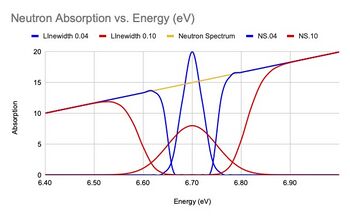User:David MacQuigg/Sandbox/Reactor Safety
Criticality and the Role of Delayed Neutrons
Can it go BOOM !!
Engineered Safety Systems
Many layers of redundant systems.
Plan for every possible human or machine failure.
Passive Safety Features
Decay Heat Tolerance
Convection Cooling
Removes decay heat even when the pumps fail
Melt Plugs
Very effective with Molten Salt Reactors
Continuous Draining
Fuel drains out without continuous pumping to replenish.
Even safer than melt plugs that could get clogged or not melt quick enough.
Intrinsic Safety - Negative Temperature Feedback
Chernobyl - never again !!
Thermal Expansion
Doppler Broadening of Neutron Absorption Lines
from Jack Devanney's Nuclear Magic: Where's the Throttle?
Figure 1. A U-238 resonance at an energy level of 6.67 eV. Vertical scale is likelihood of absorption. At low temps only the few neutrons right around 6.67 eV can be absorbed. As the U-238 heats up, more and more neutrons are candidates for absorption
There is a widespread belief that nuclear reactors cannot loadfollow. This is nonsense. In most countries, loadfollowing is a grid requirement. In fact, stable reactors are inherently loadfollowers. A stable reactor is one whose power decreases as the reactor temperature increases. This is the property of any well-designed nuclear reactor, and a strongly enforced, legal requirement.
A few early designs could be put in a state where the opposite was true, an increase in core temperature increased power which increased temperature which increased power, which ... and the whole thing goes boom. One such design was the Russian RBMK at Chernobyl. You had to work pretty hard to put the RBMK in such an unstable state; but human ingenuity was up to it, and we got the Chernobyl explosion.
All temperature stable nuclear reactors have a remarkable ability. They automatically adjust their power output to the load. If the electric load increases, the turbine control system will speed the steam flow up. The increased steam flow will extract more heat from the steam generator. This will decrease the temperature of the reactor coolant. The reactor core temperature will drop, and the reactor will increase power, without us doing anything. It's built into the physics.
Conversely, if the load drops, temperature increases, and reactor power decreases.1 If the loads drops completely, say due to a station black out, the reactor temperature will shoot up, and the reactor will shut itself down. The shutdown does not depend on a system that senses a problem and then tries to react to it. There is nothing a confused operator or malfunctioning control system can do to prevent this process.
For an old tanker operator, it's magic. For the longest time, I kept asking: where's the fuel throttle? There is none. Weird, and if you think about it, wonderful.
Further Reading
Till & Chang, Chapter 7: Safety
Jack Devanney's Substack: Nuclear Magic: Where's the Throttle?
